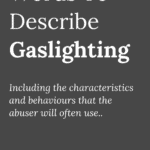Words To Describe Gaslighting (With Definitions)
What Is Gaslighting?
Gaslighting is a type of repetitive psychological manipulation that is done in order to make someone doubt their own reality and perceptions.
It can be done by a partner, family member, friend or even an authority figure such as a teacher or boss. It is a form of abuse.
The sad ‘goal’ of gaslighting is to make the victim feel isolated, confused, and stressed out so that they start doubting themselves and are more likely to comply with the gaslighter’s demands or wishes.
Gaslighting can take many forms, such as lying and denying, belittling and trivializing the victim’s feelings, making the victim feel like they are overreacting or exaggerating a situation, causing them to doubt their thoughts and memories and even accusing them of being crazy and overreacting.
Signs of Gaslighting
There are some common signs that someone is trying to gaslight you, these may include:
- They constantly contradict your version of events and deny that they ever said or did something, – even if you have proof.
- They try to make you doubt your memories of conversations or events.
- They constantly criticize you in small, subtle and what might feel insignificant at first.
- They make excuses for their behavior or blame it on someone else, but only when caught out or ‘cornered’.
- They use guilt to manipulate you into doing something they want.
- They make you feel like your feelings are invalid or unimportant.
- They encourage you to turn away from friends and family and become isolated.
If someone is constantly trying to make you doubt yourself and your reality, it’s likely that they are attempting to gaslight you in some way. In these cases, it’s important to take a step back and remember that you do not have to accept anything they say or allow them to continue their behavior.
It can be helpful to talk with someone you trust who will validate your feelings and help you identify if what is happening is indeed gaslighting. Don’t be afraid of getting a second opinion and seeking professional help when needed.
Words To Describe Gaslighting
Describing gaslighting is about describing the characteristics and behaviours that the abuser will often use. It’s important to first understand the behavior so that it can be recognized when it’s occurring. Here are some words to describe gaslighting:
Abusive: Treating someone with cruelty, violence, or other mistreatment.
Aggressive: Acting out of hostility and with force in order to get what one wants.
Bamboozling: Intentionally confusing or misleading someone in order to gain an advantage.
Belittling: Showing contempt for someone by making them feel that they are not important or valued.
Blame-shifting: Trying to shift the blame for one’s mistakes or wrongdoings onto someone else.
Brainwashing: Trying to force someone to think or behave in a certain way by using psychological techniques.
Cheating: in the case of gaslighting, some abusers use this method of control and confusion to misdirect accusations of cheating.
Coercive: Using physical force, threats, and/or psychological pressure to make someone do something against their will.
Condescending: Speaking or acting in a patronizing manner towards someone.
Confusing: Creating a state where someone cannot make sense of what is happening or how to act properly.
Control – The act of influencing or directing others through fear, force, or authority.
Control-seeking: The act of trying to gain control of a situation or person.
Deceiving: Intentionally making someone believe something that is not true.
Deceptive: Intentionally doing or saying something that is not true in order to deceive someone.
Discrediting: Trying to damage someone’s reputation or credibility.
Dishonest: Not telling the truth or acting in a deceitful manner.
Disrespectful: Showing a lack of respect or courtesy towards someone.
Fooling: Making someone believe something that is not true or convincing them to do something they would not normally do.
Humiliating: Demeaning or belittling someone in order to make them feel small or insignificant.
Insidious: Acting subtly in order to achieve an evil or immoral end.
Intimidating: Making someone feel fearful, threatened, or frightened in order to manipulate their behavior.
Isolating: Separating someone from their family, friends, and other support systems.
Lying: Not telling the truth, often with the intention of deceiving someone.
Manipulation – A type of psychological control that is used to change a person’s understanding or behavior.
Manipulative: Trying to get someone to do something by using subtle or crafty tactics.
Mean-spirited: Acting with malice, spitefulness, and/or hostility.
Misleading: Intentionally providing false information or deliberately withholding true information in order to deceive someone.
Questioning: Asking questions in order to challenge someone’s beliefs, values, or actions.
Sneaky: Trying to do something in secret or covertly.
Stonewalling: Refusing to communicate, cooperate, or compromise with someone in order to gain power over them.
Swindling: To cheat someone out of money by deceiving them.
Trivializing: Making something seem less serious, significant, or worthy of attention than it really is.
Undermining: Acting in a way that weakens or diminishes someone’s power or influence.
Unkind: Being unsympathetic or uncharitable towards someone; not exhibiting kindness.
Unreliable: Not able to be relied upon; not dependable or trustworthy.
Gaslighting is a very serious form of psychological manipulation that is aimed at making someone doubt their own perception of reality.
By understanding these words, it’s easier to recognize when someone is attempting to gaslight you. If you feel like you are a victim of gaslighting, it is important to remember that you are not alone, and that help is available. Don’t be afraid to reach out for support and take steps to protect yourself from further manipulation.







